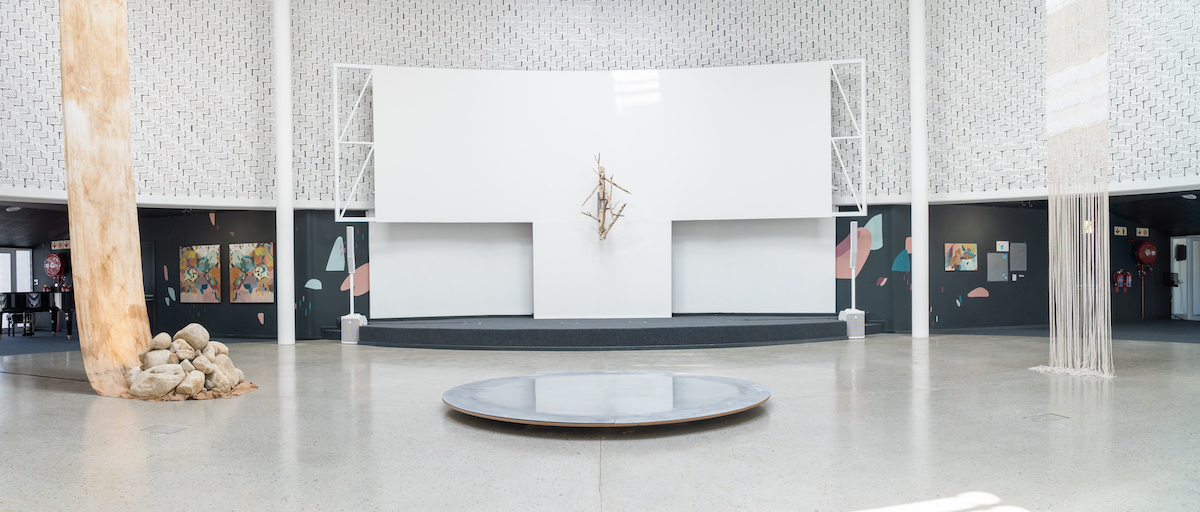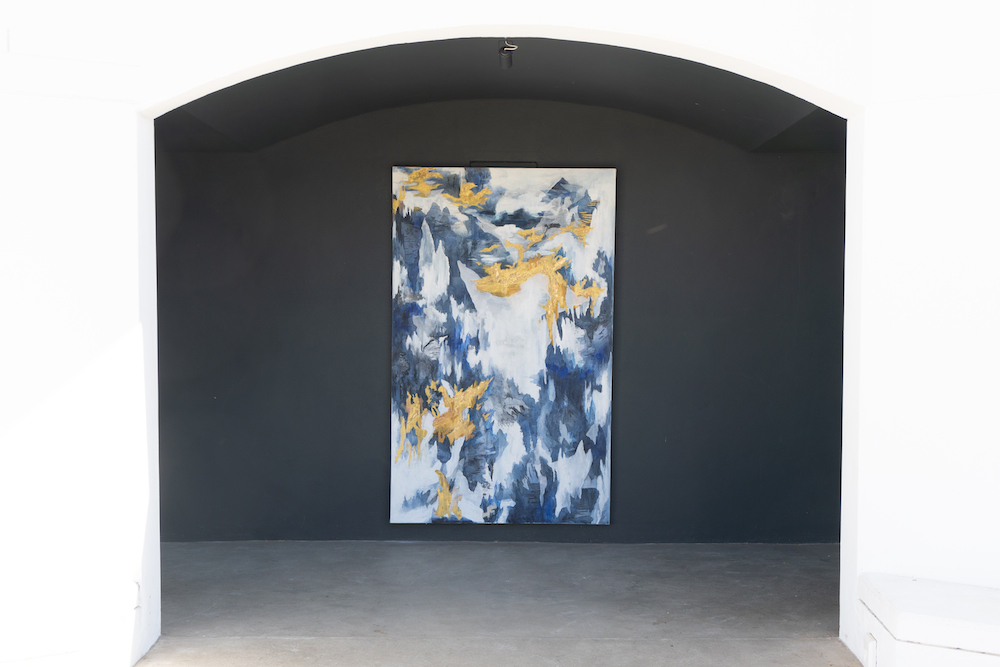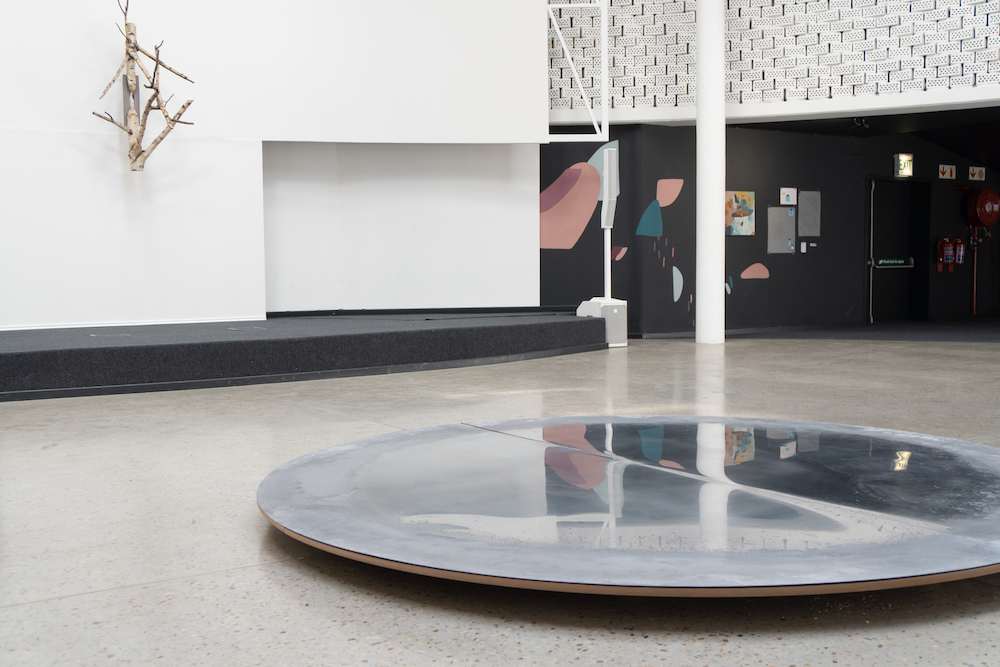Jonathan Griffiths is a visual artist and the director of 40 Stones. He draws inspiration from the beauty and grandeur of the Stellenbosch winelands where he lives.
Otto Bam is a musician, writer and student of literature from Stellenbosch, South Africa. He is a member of KRUX and seeks to cultivate a deeper understanding of the role of the imagination in Christian discipleship.

Everyday church life and contemporary art rarely share the same spaces. Some might even regard them as antithetical in nature. Contemporary art is often seen as more suited to the art gallery than the church building – the domain of the secular rather than the sacred. This is reflective of a broader tendency towards compartmentalisation in our culture. Whether it is of the sacred and the secular, intellectual and aesthetic, or physical and spiritual, such compartmentalisation has had an impoverishing effect on the church and the surrounding culture.
Transept, a recent arts project hosted by 40 Stones in collaboration with KRUX, sought to call such compartmentalisation into question. The project sought to explore ways to reintroduce, indeed, reconcile fine art and the place of worship and to explore new ways of integrating contemporary aesthetic forms into the liturgy of the church.
Twelve artists were invited to respond to the architecture of Christ Church Somerset West – a Reformed Anglican church whose new building was completed in 2019. The unassuming yet remarkable structure, which might easily be mistaken for a silo or reservoir, was designed by renowned architect Jo Noero. The building uses modest materials to great effect and achieves the stated aims of the architect to “create a space in which everything was elevated from the necessary to the beautiful.”(1) This building was the ideal setting for Transept, which similarly sought to explore ways in which to imbue the mundane with a sense of the sublime, and aid reflection on the way the commonplace is, in the words of Gerard Manley Hopkins, “charged with the grandeur of God.”(2)

The title of the project alludes to the part in earliest church architecture of the first basilicas between the nave and the apse, between the congregation and the altar. This is the symbolic threshold between heaven and earth. It is where immanence meets transcendence. The circular floor plan of the architect’s design elaborates on the idea of the transept in a way which could be read as complicating the distinction between the commonplace and the sacred. Here, heaven and earth are pictured as overlapping, and the sense of the “everyday” and the commonplace is immersed in the glorious light that enters through the cross-shaped windows above the inner ring of the building.
The opening night of the Transept exhibition (17 September 2021): Approaching the foyer of the main church building, visitors were greeted by Dévoiler, an impressive canvas with sweeping strokes of gold, white and blue.
Once inside in the church, Kompas, In Remembrance and From Dust to Dust variously drew attention to bodily orientation and perception, calling the senses from passive observation to imaginative participation. In From Dust to Dust and In Remembrance, the artist depicts artificial flowers that are commonly seen on graves to comment on our paradoxical use of plastic, which in itself is everlasting, to comment on those who have passed away, a process which to Christians is the hope of everlasting life.
Moving out from under the low ceiling of the outer rim of the building, Thin Places, Our Prayer and Axis Mundi drew one’s attention upwards from the horizontal to the vertical plane, even as one bathed in the light that fills the inner part of the building from above. Axis Mundi, with its carved tapered forms on either side of a slice of open inner space, aptly reflects the sometimes unnervingly close relationship characterized by the notion of a transept; the nearness that is possible between the one side and the other, the sacred and the commonplace. Thin Places, an installation comprising a length of cloth strewn with stains of red wine, spices, tea, dirt and flour reflects the oft messy vertical two-way conversation of a prayer in those times of life wherein we are sometimes stretched too thin.

The impactful circular centrepiece, In Part, reflected the ceiling above in its polished yet blemished surface – bringing to the floor, “as in a mirror dimly,” a glimpse of what is above.
Like Father Like Son, Breathing Prayer and Nachitindinkana, each in its own way, facilitated reflection, lament, penance, celebration and intercession, calling to remembrance those outside the walls of the church.
The Christian life is in many ways life in the transept; we live on the threshold of the already and the not yet. We are learning what it is to dwell with God in his good creation even as we await its ultimate renewal. The remarkable works that formed part of the Transept collaborative arts installation worked in synthesis with architectural space to illustrate the potential of the arts to draw attention to and counteract artificial delineations of the sacred and the everyday. This was a step towards a renewed vision for the potential role that contemporary arts may yet play in the life of the church.
For detailed information and images of each artwork, and more information about Transept visit the 40 Stones website HERE. For more information about KRUX visit www.krux.africa.
Images of Christ Church Somerset West courtesy of Paris Brummer in Visi Magazine. Images of artworks courtesy of Bianca Grobbelaar, Matthew Courtney, Heidi Liesl Salzwedel and @40 stones_.
The Kirby Laing Centre for Public Theology in Cambridge. Charity registered in England and Wales. Charity Number: 1191741
Kirby Laing Centre, The New Mill House, Unit 1, Chesterton Mill, French’s Road, Cambridge, CB4 3NP
© 2022 The Kirby Laing Centre for Public Theology in Cambridge